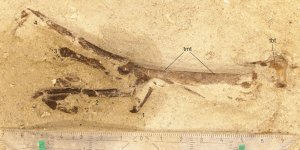Fred Ruhe
Well-known member

Gerald Mayr, Thomas Lechner and Madelaine Böhme, 2023
Nearly complete leg of an unusual, shelduck-sized anseriform bird from the earliest late Miocene hominid locality Hammerschmiede (Germany)
Historical Biology 35(4): 465–474
Abstract and free pdf: https://www.researchgate.net/public...ocene_hominid_locality_Hammerschmiede_Germany
We describe leg bones of a larger-sized representative of the Anatidae from the Tortonian of the Hammerschmiede clay pit in southwestern Germany. Allgoviachen tortonica, n. gen. et sp. differs from most other representatives of the Anatidae in tarsometatarsus characters. The holotype is among the most substantial records of an anatid from this stratigraphic period in Central Europe and shows unusual morphological features that impede a straightforward phylogenetic assignment. In overall proportions, the tarsometatarsus resembles that of the extant taxon Sarkidiornis and some Tadornini, whereas the hypotarsus morphology differs from all extant Anatidae. Because of its resemblance to the early Miocene taxa Paranyroca and Cygnopterus, the new species may be a stem group representative of the Anatidae, but more osteological data are required for a firm phylogenetic placement. We show that anseriform birds exhibit a previously unnoticed diversity of the ungual phalanges of the pedal digits, and the curved unguals of the fossil indicate a predominantly non-aquatic way of living. The Hammerschmiede avifauna also includes a very small anseriform, which may belong to the extinct taxon Mioquerquedula; equally small species of the Anatidae are today restricted to tropical and subtropical regions,
Enjoy,
Fred
Nearly complete leg of an unusual, shelduck-sized anseriform bird from the earliest late Miocene hominid locality Hammerschmiede (Germany)
Historical Biology 35(4): 465–474
Abstract and free pdf: https://www.researchgate.net/public...ocene_hominid_locality_Hammerschmiede_Germany
We describe leg bones of a larger-sized representative of the Anatidae from the Tortonian of the Hammerschmiede clay pit in southwestern Germany. Allgoviachen tortonica, n. gen. et sp. differs from most other representatives of the Anatidae in tarsometatarsus characters. The holotype is among the most substantial records of an anatid from this stratigraphic period in Central Europe and shows unusual morphological features that impede a straightforward phylogenetic assignment. In overall proportions, the tarsometatarsus resembles that of the extant taxon Sarkidiornis and some Tadornini, whereas the hypotarsus morphology differs from all extant Anatidae. Because of its resemblance to the early Miocene taxa Paranyroca and Cygnopterus, the new species may be a stem group representative of the Anatidae, but more osteological data are required for a firm phylogenetic placement. We show that anseriform birds exhibit a previously unnoticed diversity of the ungual phalanges of the pedal digits, and the curved unguals of the fossil indicate a predominantly non-aquatic way of living. The Hammerschmiede avifauna also includes a very small anseriform, which may belong to the extinct taxon Mioquerquedula; equally small species of the Anatidae are today restricted to tropical and subtropical regions,
Enjoy,
Fred
Last edited:




